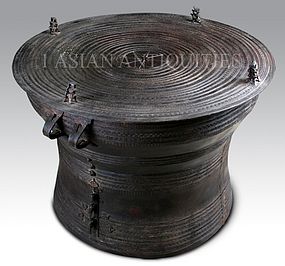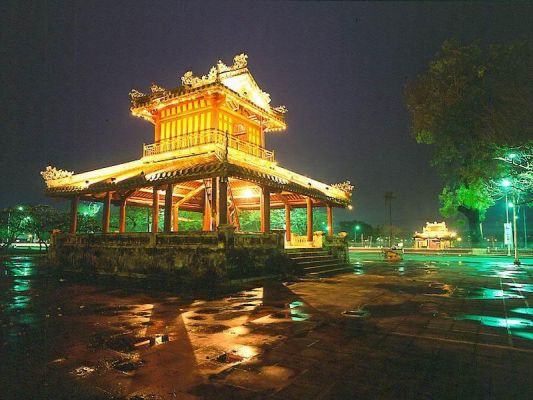??Vietnamese art has a long and rich history, the earliest examples dated back at the Stone Age, around 8,000 BCE. With the millennium of Chinese domination starting from the 2nd century BC, Vietnamese art undoubtedly absorbed many Chinese influences, which would continue even following independence from China in the 10th century AD. However, it has always retained many distinctively Vietnamese characteristics.
 Throughout the ages???
Throughout the ages???
Pottery made from clay has been found in Bac Son, Vietnam at the Stone Age (approximately 8,000 BCE). Moving into the Neolithic era, however, Vietnamese pottery and ceramics started to develop rapidly, showing signs of decor.
The highly developed Dong Son culture that flourished in North Vietnam (from about 1,000 BC to the 4th century BC) was the civilization responsible for the world-famous Dong Son drums - the product of their advanced bronze-casting skills. They were elaborately decorated with geometric patterns and most importantly depicted scenes of everyday life such as farming, warriors donning feather headdresses, construction of ships, musicians, etc.
During the ten centuries of being ruled by the Chinese, Vietnamese began to apply newly learned Chinese techniques to art and specifically ceramics, however, this was in conjunction with the continued production of art based on native methods.
From the Ngo to Tran Dynasty, the ceramics were thought to have been largely influenced by both ancient native styles and the Tang and later Song dynasty's art, including the "three colors" concept. Furthermore, Chinese - influenced philosophies adopted by the Vietnamese such as Confucianism, Mahayana Buddhism and Taoism, had a lasting impression on Vietnamese art.
The Ly dynasty in the 11th century is viewed specifically as the golden age of Vietnamese art. The Ly dynasty began the construction of many of Vietnam's landmark structures, including the Temple of Literature, One-pillar pagoda, and Quynh Lam pagoda.??
The fourth Chinese domination of Vietnam was quite short-lived, lasting only about 2 decades, yet, it was also seen as the harshest domination. A majority of classical Vietnamese books was burnt, thus, much documentation is lost. Consequently, much of the art in this period was heavily influenced by the Ming dynasty's art.
??The Nguyen dynasty, the last ruling dynasty of Vietnam, has a renewed interest in ceramics and porcelain art. Yet, despite the high development of the performing arts such as imperial court music and dance, some other fields of arts as beginning to decline during the latter part of the Nguyen dynasty.
Beginning in the 19th century, French artistic influences significantly Vietnamese art. By the early 20th century, many French art institutions such as the Fine Arts College of Indochine were erected in Vietnam which taught European methods.
Modern Vietnamese artists began to utilize French techniques with many traditional mediums such as silk, lacquer, etc., thus creating a unique blend of eastern and western elements.
Architecture
It is believed that in prehistoric times, Vietnamese people lived in stilt-houses, as depicted on the bronze Dong Son drums. When Chinese influence permeated Vietnam, its architecture had a large influence on the basic structure of many types of Vietnamese buildings, mostly pagodas and temples, communal houses, houses of scholar-bureaucrats, aristocracy and imperial palaces and quarters. Nevertheless, these structures combined both Chinese influences and native style: more sombre and muted with different colors and materials.
One of the most notable architectural structures is the Temple of Literature. The Temple is a series of courtyards, buildings and pavilions with the stone steles. These steles are placed on top of stone turtles and inscribed the names of successful candidates at the Imperial examination.
 Beside the Temple of Literature, the One Pillar pagoda is one of the most ancient structures of
Hanoi. The story goes that Ly Thai To Emperor had longed for a son. One day, he dreamed a Goddess of Mercy was sitting on a lotus flower offering him a son. In gratitude and reverence of that dream, he ordered construction of a small pagoda in the form of a lotus, overlooking a pond. The pagoda has been rebuilt many times due to it being destroyed and burnt in wars by opponents.
Beside the Temple of Literature, the One Pillar pagoda is one of the most ancient structures of
Hanoi. The story goes that Ly Thai To Emperor had longed for a son. One day, he dreamed a Goddess of Mercy was sitting on a lotus flower offering him a son. In gratitude and reverence of that dream, he ordered construction of a small pagoda in the form of a lotus, overlooking a pond. The pagoda has been rebuilt many times due to it being destroyed and burnt in wars by opponents.
During the reign of Nguyen dynasty, a new imperial citadel in Hue was built, largely based on the Chinese Forbidden city in Beijing. Some portions of the complex that used French architectural elements as well were built later such as the tomb of King Khai Dinh. However, the most beautiful structure in the entire citadel is the tomb of King Minh Mang which situated near a vast lotus pond.
The citadel formerly sprawled a vast estate, however, due to subsequent wars and conflicts, much of it has been destroyed and later turned into rice paddies. The remaining areas that you may see are currently being restored by UNESCO.
With French colonization of Vietnam in the 19th century, many French-styled buildings were constructed, including villas, government buildings, opera houses, etc. Many of them are one of the clearest remnants of the French colonial legacy.



